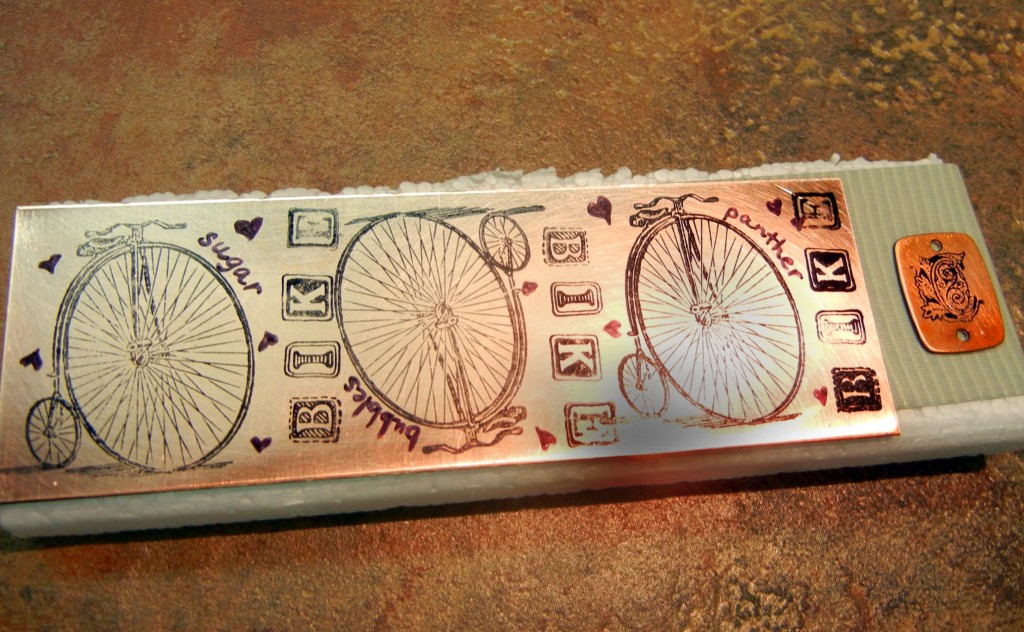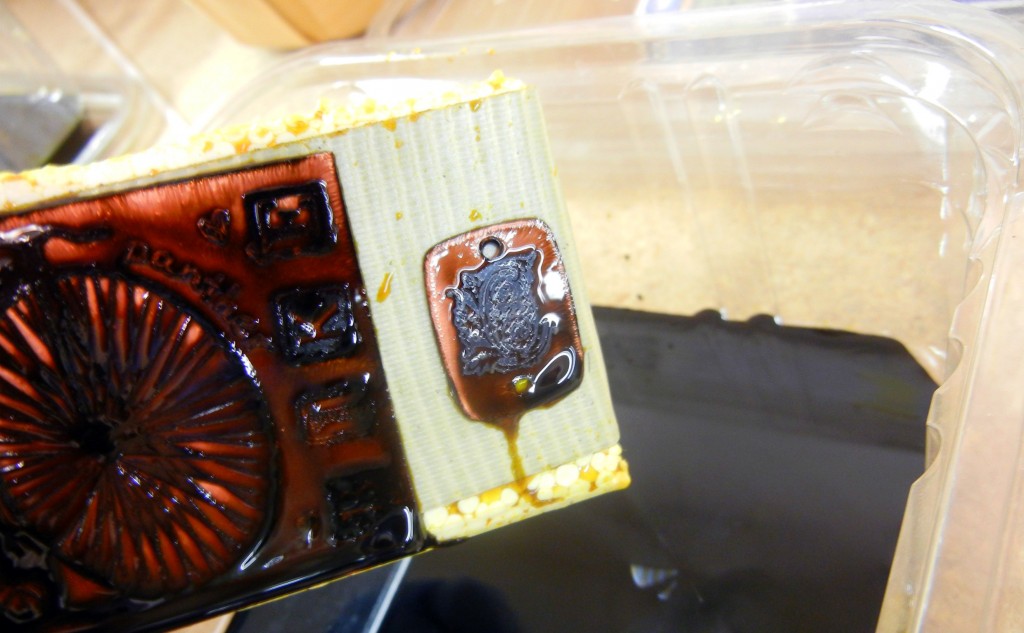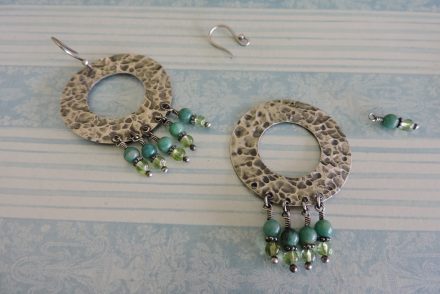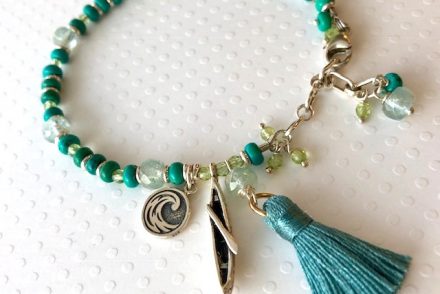Using chemicals doesn’t have to be dangerous, so long as you take basic steps to set up your work area to avoid problems. For chemical etching, you need:
- Rubber gloves (latex or nitrile).
- Safety goggles. The etching solution might splash, and you don’t want that in your eyes.
- Shop apron. The etchant will stain your clothes and anything else it touches.
- Good ventilation (open a window if possible or run an exhaust fan). Never etch in a small enclosed space. Chemical fumes and gases that aren’t noticeable in the proper setup can build to dangerous levels in a small space. Outdoors is a great place to etch, weather permitting.
- Plastic or glass containers for the etchant “bath.” We like using the clear plastic tubs from spinach or salad mixes.
- Baking soda to neutralize the acid.
- Secure screw-top plastic container to dispose of used etchant.
The basic rules for working with chemicals are simple, but worth revisiting:
- Keep pets and children out of the area.
- Don’t get it on your skin or in your eyes. Wash any splashes off immediately.
- Be careful about heating any chemical – there is a potential for toxic gases to form. Ferric chloride works faster when it is slightly warmed. You can accomplish this by putting the bottle in a warm water bath or a heat-plate set on low. Don’t try to heat it up on a stove top or in a microwave.
- Get plenty of fresh air.
- Don’t breathe in fumes or dust. It is best to clean the etched metal under water to avoid distributing particles into the air.
- Use disposable scrubbies or steel wool to clean your etched metal to avoid contaminating your good brushes, for example, with chemical residues.
- Soak up any spills with baking soda and/or kitty litter.
I know a guy who doesn’t really have any feeling left in his fingertips. You probably know someone like this too. Years of hard work have left his hands extremely callused and insensitive. For this reason, he can grab hot things with his bare hands, somehow not get splinters doing things where normal people would get splinters. I (and most anyone else) need oven mitts and work gloves for tasks he takes on bare handed.
I tell you this because sometimes I worry a bit about some of the advice on the internet. Take chemical etching. The chemicals used to etch metals are called mordants. By nature they are caustic – they eat through metal. Yet, for whatever reason, some people are extremely casual about their usage. For example, not using proper ventilation, sticking their bare hands into a chemical bath, not bothering with safety glasses, pouring the chemicals into their gardens … I’ve seen a lot of stuff that just isn’t safe. Maybe the guy on YouTube hasn’t gotten hurt doing what he’s doing – yet – but it is way better to be safe than sorry!
Obviously, it is up to each individual to determine the level of risk he or she is ok with. Some chemicals – such as the ferric chloride we use for etching copper and brass – are relatively safe, but they are still chemicals and need to be treated with care. It isn’t complicated.
In case you are wondering, ferric chloride is much, much safer than ferric nitrate and nitric acid, two mordants which are used to etch silver. While you don’t want to get it on you, ferric chloride will not eat through your skin (muriatic/hydrochloric acid, which is used in some etching recipes, will!).
And, ferric chloride in liquid form, like Rings & Things sells, is much safer than dry ferric chloride. Ferric chloride can be used more than once. Once it stops etching, follow the hazardous waste guidelines for where you live. Spokane’s are found here: https://my.spokanecity.org/solidwaste/hazardous/. Please be responsible and do not pour chemicals down the drain. (Note: all etching, even “chemical-free” etching, leaves bits of metal in the etching solution and must be disposed of properly.)
Now that you’ve read the safety guidelines, read the DIY etching tutorial and start etching!
Be safe – and have fun! ~ Cindy







8 Comments
Love all the instructions.
I try to do some etching and nothing happen ….it is etch a bit but nor enough to make it nice.
I try 45min and 90 min……
Can you tell me what I am doing wrong …..I follow all the rule and instructions.
Thanks
Elaine
Hi Elaine,
1. What metal(s) are you using? And are you sure your metal is not plated, lacquered or coated?
2. What chemical are you using, and where did you purchase it?
3. Please write down the exact steps you followed – I might notice a small but crucial step you missed.
Great ideas, Thanks for posting. Questions for you: 1. Can you reuse the Ferric Chloride? How many times? 2. How do you dispose of it?
Thanks.
Hi Susan,
1. Yes. Many, many times. Keep re-using it until it doesn’t work any more. Just keep it in a sealed plastic container. I’m using those flimsy “earthbound farms baby spinach” containers that I was saving because “they might be useful someday” … and they are!!
2. When it doesn’t work any more, pour baking soda into it to finish neutralizing it, then take it to your local household hazardous waste location for them to dispose of. It’s not terribly hazardous — it’s not going to blow up or eat through your pipes — but the copper ions in it aren’t good for the environment, so please don’t just pour it down the drain or on the ground.
hello Cindy
i need to know the law regarding metal in US.All the metal are allowed?we are based in Europe but we want to produce some jewlery for the US but need to know the law regarding allergic etc etc
thank you for your help
my email
taikaibiza@hotmail.com
Hi Emma,
In the US, lead and cadmium are banned in jewelry, especially jewelry for children.
The US rules for sterling silver (.925), fine silver (.999), and karat gold are similar to the EU rules. (Certain silver and gold alloys are standard around the world.)
The US doesn’t have as strong restrictions on nickel, as the EU. If you use the EU rules for nickel, your jewelry will pass the nickel rules in both the EU and the US easily.
For more information about good metals to use in jewelry, please read this article: http://blog.rings-things.com/2013/06/03/surgical-steel-and-hypoallergenic-metals/
hey polly! looking to etch a brass/copper cup… do you think after using the ferric chloride it would be considered a food safe item? Want to give as a gift, and would be cool if could be used to drink from! thanks!
Hi Savannah,
Yes, I don’t think that would be any problem. Just be sure to thoroughly scrub it with the baking soda (this neutralizes the etchant) and then wash the cup well. You need to do this even if you won’t be using it for food, or it will keep etching a bit. Plenty of commercially-made items are etched. Good cleaning is all that is necessary. And of course, make sure you have a good base material. I wasn’t sure if copper was ok for food but then the “Moscow Mule” drink exploded in our area, and so I see people drinking from 100% copper mugs every time I go someplace nice for dinner. ~~Polly